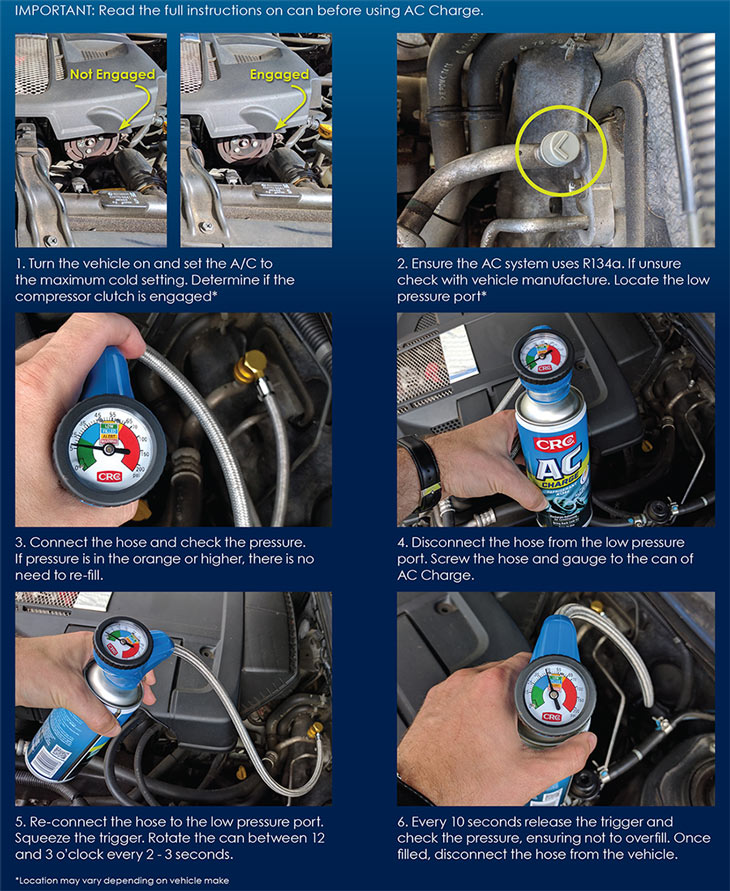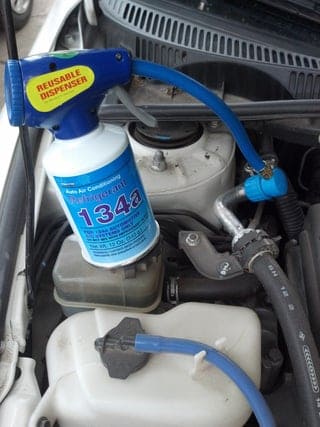To add Freon to a car, locate the low-pressure service port and attach a canister of refrigerant. Now, let’s explore the step-by-step process to add Freon to your car’s air conditioning system.
In situations where your car’s air conditioning is not cooling as effectively as it should, it may be necessary to recharge the system with Freon. Freon, also known as refrigerant, helps to cool the air in your car’s cabin by absorbing heat and releasing it elsewhere.
Adding Freon is a relatively simple process that can be done in a few minutes with the right tools and instructions. This guide will provide clear steps on how to add Freon to your car safely and effectively. By following these steps, you can improve the performance of your car’s air conditioning system and enjoy a more comfortable ride.

Credit: www.crc.co.nz
Preparation
To add freon to your car, start by gathering all the necessary tools and equipment. Ensure the car is parked on a flat surface and the engine is turned off. Put on safety goggles and gloves before carefully locating the low-pressure port on the AC system.
Proceed by attaching the recharge hose to the port, and refer to the owner’s manual for the specific amount of freon needed for your vehicle. After adding the freon, detach the hose and start the car to allow the AC to cool the interior.
Gather Necessary Materials
Before you begin adding Freon to your car, it’s essential to gather all the necessary materials to ensure a smooth and successful process. By having everything you need within reach, you can save time and avoid unnecessary interruptions. Here are the materials you’ll need:
- R134a refrigerant: Make sure to check your car’s specifications to determine the correct refrigerant type.
- Pressure gauge: This will help you monitor the pressure levels while adding Freon.
- Refrigerant dispenser: An easy-to-use dispenser will allow you to control the flow of Freon into your car’s system.
- Protective gloves and eyewear: Safety should always be a priority, so make sure to wear gloves and eyewear to protect yourself from any potential hazards.
Prep The Work Area
Preparing your work area is essential to ensure safety and efficiency while adding Freon to your car. Follow these steps to set up your work area:
- Park your car in a well-ventilated area: It’s crucial to work in a space that has good airflow to prevent exposure to excess Freon.
- Turn off the engine: Before you begin any work on your car’s refrigerant system, make sure the engine is off to avoid accidents.
- Locate the low-pressure port: Identify the low-pressure port on your car’s air conditioning system. Referring to the owner’s manual can help you find it easily.
- Clean the port: Use a clean cloth or rag to wipe any debris or dirt away from the low-pressure port. This step will prevent any contaminants from entering the system.
- Secure the work area: Make sure to clear any clutter or obstacles around your work area to create a safe and organized space.
Locate Low-pressure Service Port
In order to add Freon to your car’s air conditioning system, it is crucial to first locate the low-pressure service port. This port allows you to access the system and add the necessary refrigerant. Understanding your car’s layout and identifying the low-pressure service port are the key steps to take. Let’s dive into each of these steps in detail.
To effectively locate the low-pressure service port, it’s important to have a basic understanding of your car’s layout. Each car model may have a slightly different layout, but the general components remain the same. The low-pressure service port is typically located on the air conditioning system’s refrigerant line.
1. Start by opening the car hood and locating the air conditioning system components. Look for the thick metal lines that connect to the compressor, condenser, and evaporator.
2. Once you have located these lines, inspect them closely. You are specifically looking for the one labeled as the low-pressure line. This line is usually larger in diameter and has a blue or black cap on the service port.
| Component | Location |
|---|---|
| Compressor | Located at the front of the engine, usually with a belt connected to it |
| Condenser | Located near the radiator, in front of the car |
| Evaporator | Located inside the car, often behind the dashboard |
3. Once you have identified the low-pressure line, remove the cap from the service port. This will expose the valve where the Freon will be added.
4. It’s important to note that the low-pressure line is different from the high-pressure line. The high-pressure line is typically smaller in diameter and has a red or black cap. Do not confuse the two, as adding Freon to the high-pressure line can cause damage to your air conditioning system.
By thoroughly understanding your car’s layout and identifying the low-pressure service port, you are now ready to proceed with adding Freon to your car’s air conditioning system. Make sure to follow the manufacturer’s guidelines and use caution when working with refrigerant. With the low-pressure service port located, you can now continue with the next steps to complete the process.
Attach And Charge The System
When it’s time to attach and charge the system, you are ready to add the final steps to complete the process. This phase involves connecting the charging hose and adding freon to the car, ensuring that the system is properly charged for optimal performance. Follow the following steps to get the job done correctly.
Connect The Charging Hose
Begin by finding the low-pressure port on the car’s AC system. It is usually located near the AC compressor. Remove the port cap and connect the charging hose to the port. Ensure a secure connection to prevent any leaks during the charging process.
Add Freon To The Car
Once the charging hose is securely connected, it’s time to add freon to the car. Start the car and turn the AC to the maximum setting. Then, slowly open the valve on the charging hose to allow the freon to enter the AC system. Monitor the pressure gauges to ensure the proper amount of freon is added.
Check For Leaks
Before adding Freon to your car , always check for leaks to ensure optimal performance. Leaking refrigerant can affect the AC system’s efficiency and may lead to further issues.
Use Leak Detection Kit
Utilize a leak detection kit to locate any potential leaks in the AC system . These kits contain UV dye that is visible under a UV light, making it easier to spot leaks.
Inspect For Any Visible Leaks
Thoroughly inspect the AC components for any visible signs of leaks , such as oily residue or refrigerant stains. Identifying and fixing leaks promptly can help prevent further damage.
Final Checks And Testing
Final Checks and Testing are crucial steps for adding Freon to your car. These steps ensure proper functioning and efficiency.
Recheck The Freon Level
1. Obtain a freon level gauge to recheck the refrigerant level accurately.
2. Attach the gauge to the low-pressure port of the air conditioning system.
3. Start the car and turn on the air conditioning to the maximum setting.
Test The Air Conditioning System
1. Check for proper cooling after adding Freon to the appropriate level.
2. Inspect the vents to ensure adequate airflow and cold air coming out.
3. Listen for any unusual noises or vibrations that could indicate issues with the system.

Credit: www.amazon.com

Credit: www.instructables.com
Frequently Asked Questions Of How To Add Freon To A Car
How Much Does It Cost To Recharge Freon In Your Car?
Recharging Freon in your car can cost around $100 to $400, depending on the type of vehicle and location. Prices vary due to the amount of refrigerant needed and labor involved. It’s best to consult a professional automotive technician for an accurate quote.
How Do You Know If Your Car Needs Freon?
If your car’s air conditioning is blowing warm air or not cooling properly, it may need Freon. Look for signs like reduced cooling power or hissing noises when the AC is running. A professional inspection can confirm if your car requires a Freon recharge.
Can You Add Freon Without Car Running?
Yes, you can add Freon to a car without it running, but make sure the engine is off.
How Do I Know How Much Freon To Put In My Car?
To determine the correct amount of Freon for your car, consult the manufacturer’s specifications or a professional technician.
Conclusion
Adding Freon to your car is a simple task that can save you time and money. By following the steps outlined in this post, you can ensure your vehicle’s air conditioning system operates efficiently. Remember to always consult your owner’s manual and seek professional help if needed.
Keep your car cool and your wallet happy!
